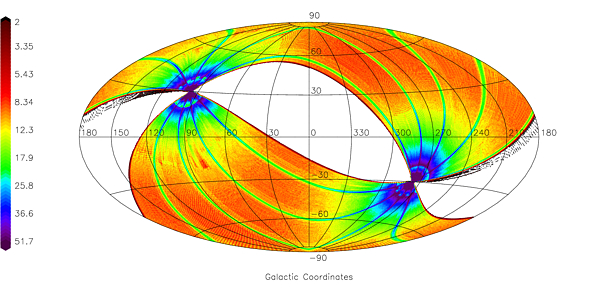


VIII. Post-Cryo Data Release
2. Post-Cryo Release Data Products
The NEOWISE Post-Cryo Data Release products were generated using
data taken during the mission's Post-Cryo survey phase. This phase
covers the time following the exhaustion of solid hydrogen in the WISE payload
inner cryogen tank, when the
detectors and optics gradually warmed until they reached
a stable equilibrium temperature near 73.5 K
(VIII.1.a.i).
During this time, WISE's W1 and W2 detectors
continued to acquire high quality imaging data with sensitivities close
to that during the mission's cryogenic survey phases. The W3 and W4 detectors
were fully saturated by the thermal emission from the warming telescope.
WISE scanned approximately 70% of
the sky during the Post-Cryo survey phase continuing with the
same strategy that was used during the full cryogenic survey.
WISE scanned along lines of constant ecliptic longitude from near one
ecliptic pole to near the other pole with a scan rate close to the orbital
rate of 3.8 arc-minutes/second in order to always point away from the Earth.
Each semi-circular track from ecliptic pole to ecliptic pole is called
a scan. During each scan
WISE took a frameset every 11
seconds. Each Post-Cryo frameset contains
two images, one for each of the W1 and W2 bands, both
observing the same 47x47 arc-minute square patch of sky.
The Post-Cryo Releases include the
Single-exposure images (Level 1b)
and a
Database of all source
detections extracted on the Single-exposure images. This database
is useful to recover the individual flux measurements and positions
of solar system objects identified by the
WISE Moving Object Pipeline System. It can also
be used as a resource to learn more about inertial objects
that are found in the WISE All-Sky Release Catalog, such
as flux variability and/or proper motion.
The Single-exposure images and source database include
all of the Single-exposure image data, regardless of
frame quality.
The 2013 Post-Cryo Release products are based on
second-pass processing of the
Post-Cryo image data that incorporated calibrations and algorithms
that were optimized for the performance of the warm detectors and telescope.
The 2013 Release products supersede those of the July 2012
Post-Cryo Preliminary Release that were based on very early
first-pass processing
that was largely still tuned for the cryogenic payload performance.
Users should always defer to the 2013 Post-Cryo Release data
products.
The Post-Cryo Data Releases do not include
the coadded Atlas Images and deep source extractions that
are part of the All-Sky and 3-Band Cryo Releases.
- Range of Observation Dates Represented in the Post-Cryo Release:
- 2010 September 29 18:41:16 UTC to 2011 February 1 11:03:01 UTC
- Number of Scans and Single-Exposures Represented in the Post-Cryo Release:
- Scans: 3,775
- Single-Exposures: 901,271 (901,274 in the Post-Cryo Preliminary Release)
- Area Covered by the Post-Cryo Releases:
- Ecliptic longitude ranges covered by all Post-Cryo scans: 89.4°<λ<221.8° and 280.6°<λ<48.2°
- Approximate area covered by the Post-Cryo observations to any depth: 29,793 deg2
 |
| Figure 1 - Galactic projection sky plot showing the average raw
frameset depth-of-coverage in 14'x14' spatial bins during the WISE Post-Cryo
survey phase. Colors encode the average depth-of-coverage indicated by the
key on the left side of the diagram.
|
Last Updated: 2013 May 20






